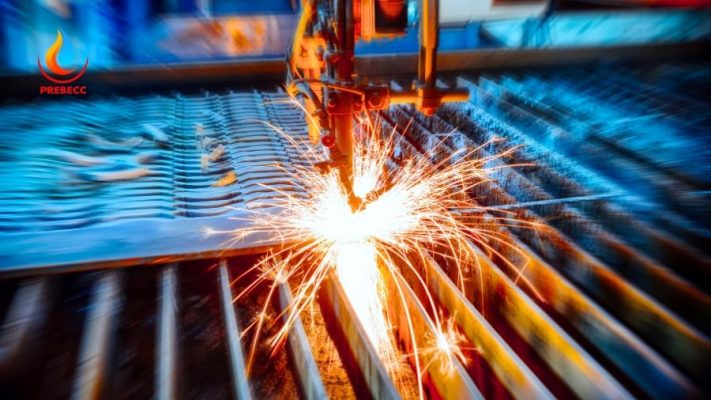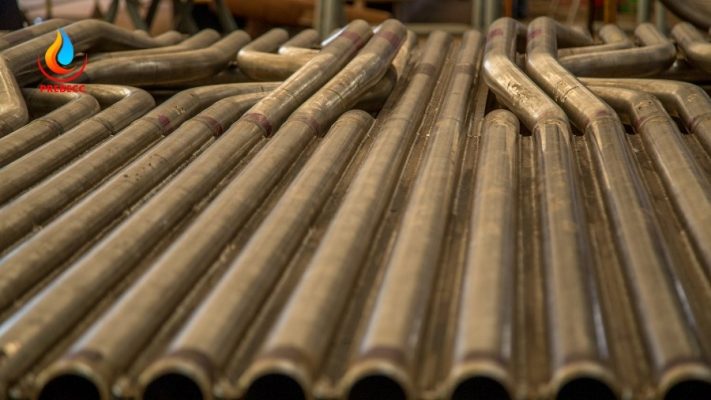The ASME Boiler and Pressure Vessel Code (BPVC) is one of the most crucial technical standards worldwide, widely used in the design, manufacture, and inspection of boilers and pressure vessels. This standard was established to ensure safety in the use of pressure equipment, which poses significant risks if not designed and operated correctly.
1. History and Development
1.1. History of the ASME Code
The ASME Boiler and Pressure Vessel Code (BPVC) is a key standard in the pressure equipment manufacturing industry. It not only ensures safety but also supports sustainable technology development and helps manufacturers maintain high product quality.
BPVC was first developed in the late 19th century, as industrial facilities increasingly used boilers and pressure equipment. Over the decades, BPVC has been continuously updated to meet the growing demands of technology and safety regulations. New editions of BPVC are periodically issued, incorporating changes to improve performance, minimize risks, and address new industry requirements.
1.2. Key Functions
a) Providing Uniform Technical Standards:
BPVC offers standardized technical guidelines, allowing designers, manufacturers, and inspectors to follow a common set of standards. This ensures that all boilers and pressure vessels adhere to a unified quality and safety system, enhancing compatibility and reducing costs for businesses.
b) Minimizing Risk of Accidents:
BPVC focuses on reducing risks associated with boilers and pressure vessels, such as boiler explosions, hazardous gas leaks, or operational failures. These standards help minimize workplace accidents, protect assets, and prevent severe consequences. Adhering to strict regulations on inspection, maintenance, and operation ensures safe production and operation processes.
c) Increasing Reliability and Longevity:
Equipment designed and manufactured according to BPVC tends to be more reliable and durable, reducing maintenance and repair costs throughout its lifespan. This not only boosts productivity but also cuts down on expenses related to malfunctions or downtime, optimizing plant operations and economic efficiency.
d) Promoting Technological Advancement and Performance Improvement:
BPVC is regularly updated to reflect the latest technological advances, ensuring that boilers and pressure vessels meet the highest industry standards. This continuous innovation supports manufacturers in enhancing competitiveness and fosters sustainable and effective development in heavy industries.
e) Supporting Legal Compliance and International Standards:
Many countries and regions require adherence to BPVC as part of their safety and technical regulations. Compliance with BPVC facilitates the export of products to international markets, ensuring global quality and safety standards. This is crucial for businesses with overseas customers, ensuring that products meet global standards.

1.3. Important Sections in the ASME Code
The BPVC is divided into several sections, each focusing on specific areas related to the design, manufacture, and inspection of boilers and pressure vessels. Key sections include:
- Section I: Power Boilers: This section provides rules for the design, manufacture, and inspection of industrial boilers, including those fired by coal, oil, and gas.
- Section VIII: Pressure Vessels: This section focuses on pressure vessels that are not boilers, such as storage tanks, gas cylinders, and similar equipment.
- Section II: Materials: This section provides specifications for materials used in the manufacture of boilers and pressure vessels, including types of steel, alloys, and non-metallic materials.
- Section III: Nuclear Power Plant Components: This section is dedicated to components of nuclear power plants, including specific requirements for design, manufacture, and inspection.
- Other Sections: BPVC also includes other sections, such as Section V (Nondestructive Examination), Section IX (Welding Qualifications), and appendices that provide additional information.
2. Designing Pressure Vessels According to ASME Section VIII
ASME Section VIII is a crucial standard widely applied in the design, manufacture, and inspection of pressure vessels. This standard ensures safety, equipment reliability, and optimizes operational and maintenance efficiency.
2.1. Classification of Pressure Vessels According to ASME Section VIII
Pressure vessels under ASME Section VIII are classified into three divisions: Division 1, Division 2, and Division 3, each with different requirements and complexities.
- Division 1: Applies to standard pressure vessel designs. This is the most commonly used classification, with less complex calculation, analysis, and inspection requirements. It is suitable for general industrial applications such as oil and gas, food, and chemicals (Design pressure up to 3000 psi ~ 206.8 bar).
- Division 2: For designs requiring higher reliability and safety, typically used in special industries like nuclear energy, chemicals, and high-tech equipment. This classification demands more detailed calculations and analysis, including non-destructive testing (NDT) and stress analysis (Design pressure up to 10,000 psi (689.5 bar) or higher, depending on the application).
- Division 3: Applies to pressure equipment operating under extreme conditions, such as very high pressure (e.g., in oil and gas industry, mining, or deep underwater environments). Division 3 requires precise stress and strength analysis, including specialized software simulations (Design pressure exceeding 10,000 psi (689.5 bar) and up to 100,000 psi (6,895 bar) in some special cases).
2.2. Design Requirements for Pressure Vessels According to ASME Section VIII
Pressure vessel design must comply with detailed technical requirements to ensure safety and reliability. Key requirements include:
- Design Pressure: The maximum working pressure the vessel can withstand under normal operating conditions. The design pressure should be calculated based on safety requirements and always be higher than the actual operating pressure to ensure a safety margin.
- Example: For a pressure vessel with an operating pressure of 100 psi, the design pressure might be 120-150 psi depending on applied safety factors.
- Design Temperature: The maximum temperature at which the vessel can safely operate. Excessive temperatures can affect the material’s mechanical properties, so the design temperature must align with the material and application.
- Example: Design temperatures typically range from -20°C to +650°C, depending on the material and working environment.
- Material Selection: The material of the pressure vessel must withstand the operating pressure and temperature. Common materials include carbon steel, alloy steel, and stainless steel. Material choice also depends on corrosion resistance, temperature tolerance, and pressure capacity.
- Example: A516 Gr 70 steel is often used for pressure vessels operating at moderate temperatures and pressures.
- Thickness Calculation: The thickness of the vessel walls and base is calculated based on the working pressure, diameter, and other factors such as material type and manufacturing method. Greater thickness enhances the vessel’s strength but also increases cost and weight.
- Example: The minimum thickness for a vessel wall is typically calculated using the formula:
In which:
- P: Working Pressure
- D: Inside Diameter of the Vessel
- S: Material Yield Strength
- E: Weld Efficiency Factor
- Welding Requirements: Welds must be performed according to ASME Section IX standards, ensuring high quality and durability. Welding inspection includes non-destructive testing (NDT) and visual inspection (VT).

2.3. Pressure Vessel Design Methods per ASME Section VIII
There are two main methods for designing pressure vessels:
Design by Rule (DBR): This method relies on the formulas and tables provided in the ASME BPVC. It is straightforward, quick, and easy to apply, suitable for pressure vessels with simple designs and standard operating conditions. For instance, when designing a simple pressure vessel like an air compressor tank, DBR can be used for quick calculations of wall thickness and other parameters without complex analysis.
Design by Analysis (DBA): This method uses simulation software and stress analysis to calculate the detailed stresses and strength of the pressure vessel. DBA is appropriate for complex designs or severe operating conditions that require higher accuracy. For example, in designing pressure vessels for nuclear or petrochemical applications, DBA is used to precisely assess factors such as thermal and mechanical stresses.
3. Materials and Testing in Pressure Vessel Manufacturing
Selecting materials for pressure vessels is critical because it determines the vessel’s ability to withstand harsh conditions such as high pressure, temperature fluctuations, and corrosive environments. According to ASME Section II, accepted materials must meet standards for chemical composition and mechanical properties. Here are some common materials:
Carbon Steel: The most common material for pressure vessels, especially for applications operating at low to medium temperatures and pressures. Carbon steel is easy to machine, cost-effective, and performs well under normal conditions.
- Applications: Carbon steel is used in air tanks, steam boilers, and pressure vessels in the oil and gas industry.
- Typical Materials: ASTM A516 Gr 70, A106 Gr B.
Alloy Steel: Contains alloying elements like molybdenum and chromium, enhancing strength and heat resistance. Suitable for high-temperature and high-pressure conditions.
- Applications: Pressure vessels for high-temperature environments, petrochemical, and energy sectors.
- Typical Materials: ASTM A387 Gr 22, A335 Gr P91.
Stainless Steel: Offers high corrosion resistance and is used in specialized applications such as harsh chemical environments or food industries.
- Applications: Acid tanks, vessels in food and chemical processing plants.
- Typical Materials: ASTM A240 Type 304, Type 316.
Non-metallic Materials: Includes plastics and composites used for specific types of pressure vessels. These materials are not as common as metals but offer advantages like lightweight and high corrosion resistance.
- Applications: Pressure vessels in chemical processing, water treatment, or corrosive environments.
4. Testing and Certification of Pressure Vessels
After manufacturing, pressure vessels must undergo several testing and evaluation stages to ensure quality and safety before use. This process typically includes:

Material Inspection: Before fabrication, materials are tested for chemical composition and mechanical properties to ensure they meet technical requirements and can withstand operational conditions.
- Methods: Spectroscopy, hardness testing, tensile strength testing, and other required property tests.
Dimensional Inspection: After manufacturing, the vessel’s dimensions, including wall thickness, diameter, and other parameters, are meticulously checked to ensure they match design specifications.
- Methods: Using precision measuring tools like calipers, gauges, and coordinate measuring machines (CMM).
Welding Inspection: Welds are crucial to the vessel’s structure and must be inspected for defects or flaws that could lead to leaks. Non-destructive testing (NDT) methods are used to assess weld quality without affecting the structure.
- Methods: Common methods include Ultrasonic Testing (UT), Radiographic Testing (RT), and Magnetic Particle Testing (MT).
Hydrostatic Test: One of the most critical tests. The vessel is filled with water and subjected to a pressure higher than the working pressure (usually 1.5 times the design pressure) for a period to test its strength and durability.
- Example: A pressure vessel with a design pressure of 1000 psi will be tested at 1500 psi.
Liquid Penetrant Testing (PT): Used to detect surface cracks, porosity, or defects on the vessel or welds. Penetrant fluid is applied to the surface and then cleaned off; defects, if present, will be revealed under UV or white light.
Certification: After passing all tests, the pressure vessel is certified by ASME. This certification ensures that the vessel meets all ASME standards and regulations and can operate safely under real-world conditions.
- ASME U-stamp: The vessel will receive an ASME U-stamp, indicating that it has been certified by an ASME-authorized inspection agency.
